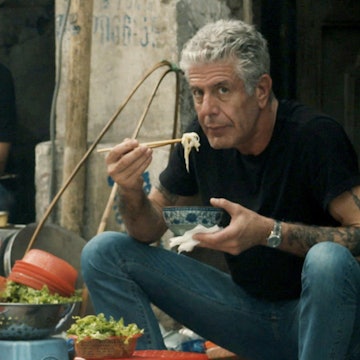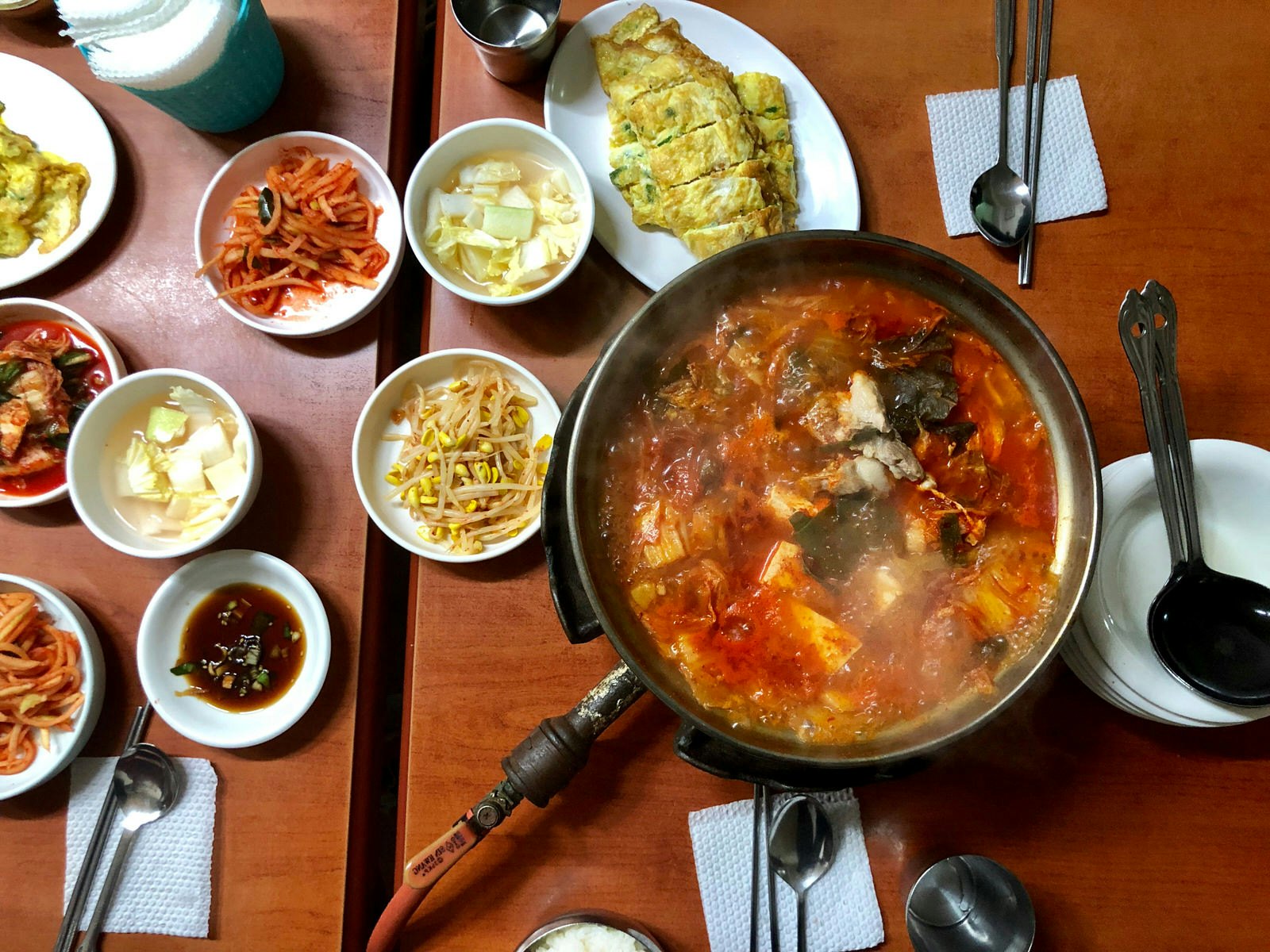

A table with several dishes of food including a large pot of spicy red kimchi stew at Gwanghwamun in Seoul.
Quieted away, around the corner from one of South Korea's grandest hotels is a great food secret: Gwanghwamun Jip. Its worn-out blue sign gives away the restaurant’s long history, and with one spicy spoonful of the signature kimchi stew, it’s clear why droves of locals queue up here at lunchtime.
South Korea's cities are full of wonderful hole-in-the-wall restaurants secreted off down back streets. Too often, these are missed by visitors, though they represent some of the country’s best and most authentic eating. Many are run by families (very often, grannies) that lived through Korea's tumultuous 20th century. They cater to local tastes, don’t make adjustments to their dishes and aren’t afraid to demand cash. Though service might feel a bit gruff, if you flash a smile and attempt at a few words in Korean, you’ll likely find yourself showered with sudden warmth.

Many of South Korea’s mom ‘n’ pop restaurants pride themselves on two or three star dishes and really perfect them. It helps to know what to order before you set foot inside: soups such as gamja-tang (pork back stew) and seolleongtang (ox-bone soup), and noodles like naengmyun (iced noodles) or kalguksu (knife noodles) are the most typical offerings.
Identifying these dive restaurants can be tricky, and a worn interior isn’t everything. The best usually have lines out the door at lunch, fading wallpaper and a few framed newspaper clippings of a political figure or celebrity eating there.
We’ve chosen our favourite South Korean hole-in-the-wall restaurants, where – behind an unassuming door – you can fill up on generous portions of traditional food served with a dash of no-nonsense Korean culture.

Gwanghwamun Jip
Gwanghwamun Jip originally opened as an octopus stir-fry and doenjang-stew (soy-bean paste stew) restaurant in 1950, when the vintage blue sign was originally put up. In 1980, it was redeveloped into one of Seoul's most enduring kimchi-stew restaurants. The three ladies (now in their 70s) who own and operate the joint prepare approximately 2000 heads of kimchi every year. Not only is their stew a perfect balance of fatty pork and ripened kimchi, it’s free of all the MSG that some other stew restaurants lather on. For an extra ₩5000, pair the spicy soup with a mild-but-delicious steamed egg roll. Table seating is available on the first level, but when possible, climb up the narrow stairs of death and try the Korean-style heated-floor seating on the second level.
12 Saemunan-ro 5-gil, Jongno-gu, Seoul
Eulmildae
After migrating south during the Korean War, Kim In-joo opened Eulmildae in 1971 and named it after a pavilion near her former home in Pyongyang. The restaurant is most famous for its North Korean-style naengmyun (iced noodles) cooked three different ways: mul (in chilled broth), bibim (with thick spicy sauce) and hoe (with raw fish). The star dish is, by far, the mul-naengmyun – thin, chewy noodles and a slightly sour cool broth are a must on summer days. In the past few years, Eulmildae has franchised, adding a handful of locations around Seoul. However, any naengmyun-lover will tell you that the original location in Mapo is still the best. Real pros will advise you to ask for the mul-naengmyun without ice (eol-eum bbae-ju-se-yo), as it's the freshest version.
24, Soongmun-gil Mapo-gu, Seoul

Kangsan Myeonok
Kangsan Myeonok in the city of Daegu dates back to 1951, when the founding family left North Korea during the war and started cooking recipes reminiscent of their home. Its current location, on the second floor of an old shopping plaza, opened in 1958. The restaurant is known for its Pyeongang-style naengmyeon (iced noodles), but the real winner is the galbi-jjim (braised beef short ribs). The soft, tender meat forks apart easily and the sweet marinade will have you licking the stone pot clean.
27-8 Gyodong-gil, Jung-gu, Daegu
Hadongkwan
The unassuming wooden-door exterior of Hadongkwan can seem intimidating for many a traveller, but venture in for a treat. The restaurant only serves two dishes: suyuk (boiled beef) and gomtang (beef-bone soup). The soup comes in two sizes, regular and large, and can be kicked up with a side of their garlicky kimchi. Fans of Hadongkwan swear that the depth of the broth and the tenderness of the meat are incomparable to any other gomtang restaurant in South Korea. In fact, rumour has it that former President Park Chung-hee was so obsessed with the restaurant that he ordered 30 bowls of the specialty soup while on a business trip to Jeju-do.
12 Myeongdong 9-gil, Jung-gu, Seoul

Ddoongbo Jip
Located on Busan’s famous jjukumi (webfoot octopus) street, the name of this restaurant – opened in 1982 – literally means ‘Fatty’s House’. Crowds of people line up for the spicy, leggy delicacy at Ddoongbo Jip in stubborn confidence of the venue’s superiority over its competitors along the street. Jjukumi here is grilled over charcoal right beside the entrance, and each generous portion is served with a basket of vegetables, soybean curd and a soup of the day. For those less inclined to munch on cephalopod, the bossam (pork belly) wrapped in kimchi and the rokbin (deep-fried shrimp pancakes) are in equally high demand. Some might even argue that the bossam is the real dish to try.
3 Jungang-daero 41beon-gil, Jung-gu, Busan
Golmok Bunshik
Possibly the most off-the-beaten-track place on this list, Golmok Bunshik is located in a half-basement on Yeongdo in Busan. Run by an elderly couple, the 30-year-old restaurant serves various types of ramyeon (Korean instant noodles) and keeps a collection of a dozen or so vintage comic books. Their most famous bibim-myeon is made by boiling the noodles, adding a signature spicy sauce and sprinkling sesame and cucumber seeds on top. For a warmer option, try the ₩1500 original noodles. Although it’s literally just ramyeon out of the package, the consistency of the noodles will make you feel as if you’re eating instant noodles for the first time.
12 Jungnibunk-ro 22beon-gil, Yeongdo-gu, Busan

Dongwon Jip
Even on the coldest winter nights, you’ll see a line outside Dongwon Jip in Euljiro3ga. Opened in 1987, the restaurant is most famous for its gamja-guk (pork-back soup) and soondae-guk (blood sausage stew). Owner Yoon Soon-young credits the restaurant’s consistency over the years for its popularity. The gamja-guk broth is cooked overnight in a large, haphazard stone pot near the entrance and the meat is tenderised for three hours before being served. Louder and rowdier than similar hole-in-the-wall establishments, Dongwon Jip serves soju (Korean distilled spirit) and beer in addition to meals, and is sometimes affectionately called a ‘delicious bar’.
22 Eulji-ro 11-gil, Jung-gu, Seoul















